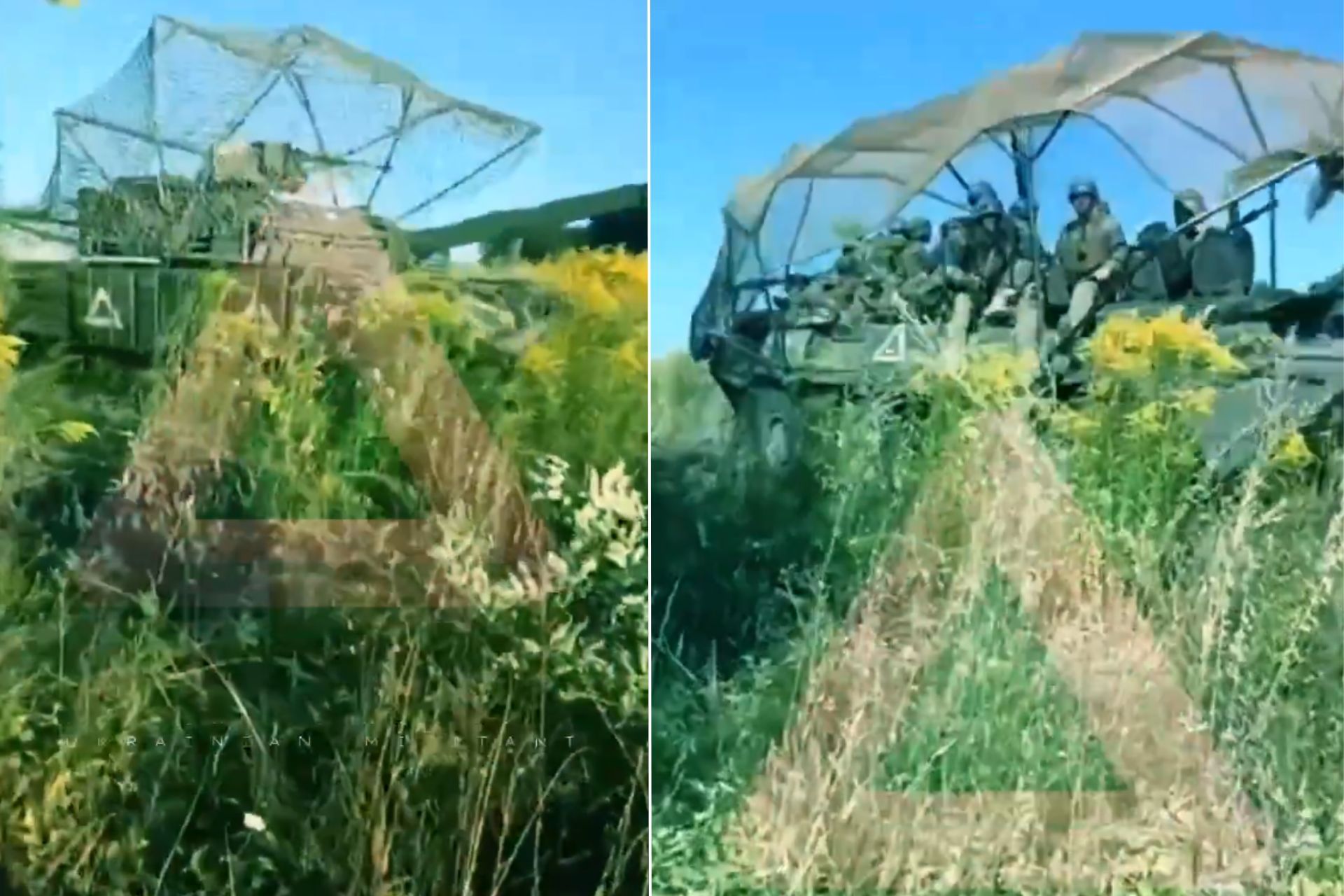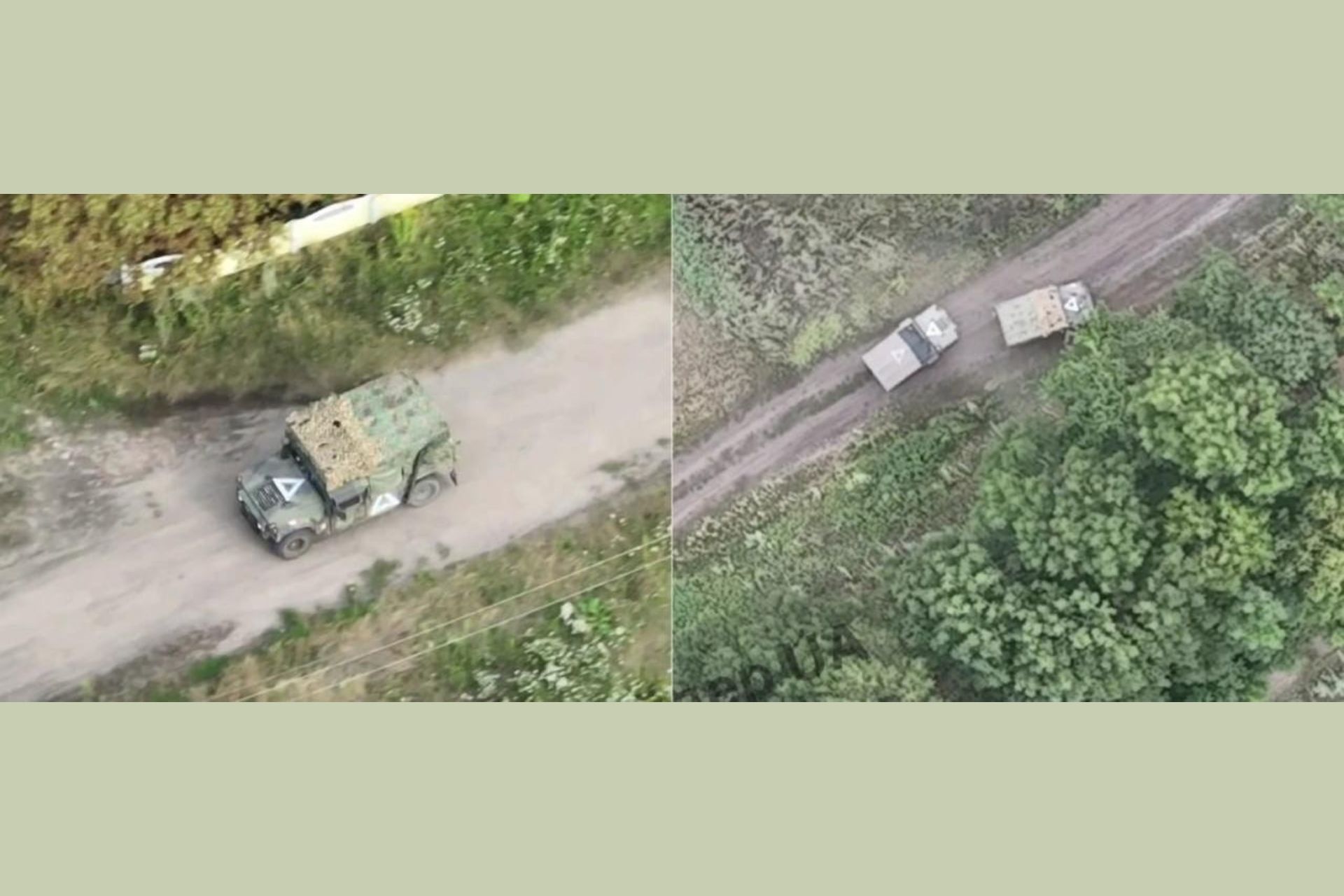Breaking News
Ukrainian Forces Launch Cross-Border Raids into Russia's Kursk Region.
On August 6, 2024, Ukrainian forces launched a series of cross-border raids into Russia's Kursk Oblast, marking a significant escalation in the ongoing conflict between the two nations. According to Russian sources, these operations involved a battalion-sized force equipped with tanks and armored vehicles, targeting Russian positions near Nikolayevo-Darino and Oleshnya, located northwest of Sumy City along the Russia-Ukraine border. Follow Army Recognition on Google News at this link

Screenshot of a video showing Ukrainian tanks and armored vehicles in Russia's Kursk region. (Picture source: X channel @ClashReport)
The Russian Ministry of Defense (MoD) and the Federal Security Service (FSB) claimed to have repelled the Ukrainian incursions, which originated from two main directions. The first attack began at the Sudzha checkpoint, northeast of Sumy City, advancing towards Sudzha and Oleshnya. The second wave came from Novehke in Sumy Oblast, pushing towards Nikolayevo-Darino. Geolocated footage published on August 6 showed damaged and abandoned armored vehicles approximately seven kilometers north of the border near Lyubimovka. However, it is not confirmed whether these vehicles belonged to Ukrainian or Russian forces.
The Russian Ministry of Defense reported that their forces destroyed 16 Ukrainian armored vehicles during the raids, while Russian reserve forces and elements of the Chechen "Akhmat" Spetsnaz were deployed to respond to the incursions. Ukrainian forces reportedly used tanks, armored personnel carriers, and other armored combat vehicles, suggesting significant logistical support, possibly from Western allies.
Russian sources, including military bloggers, largely downplayed the effectiveness of these raids, labeling them as "unsuccessful" and a "media stunt." However, the acting governor of Kursk Oblast, Alexei Smirnov, indicated that fighting continued in the border areas, and some Russian military bloggers warned of potential further incursions, suggesting a diversion tactic by Ukrainian forces to draw Russian resources away from other fronts, particularly in northern Kharkiv Oblast.
Several Ukrainian sources closely linked to the military reported the loss of one of Russia's advanced Su-35 fighter jets in the Kursk region. The Telegram channel "Polkovnik GSh" hinted at this loss in its messages, and various Ukrainian monitoring groups stated that Russia withdrew its strike aircraft following the destruction of the Su-35.

Ukrainian Humvees with the tactical sign "Triangle" near the border with Kursk Oblast (Picture source: X channel @MilitaryNerdd)
According to these reports, Russian aviation ceased using Su-35 and Su-34 aircraft at high altitudes in the area of the Ukrainian breakthrough, instead focusing on Su-25 and attack helicopters that use unguided munitions rather than precision-guided rockets and bombs.
Although Russian sources have not confirmed the loss of the Su-35, they acknowledge the concentration of Ukrainian air defense systems in this section of the front. Ilya Tumanov, a prominent figure in the Russian military aviation community and administrator of the 'Fighterbomber' channel, commented that Russian military aviation is attempting to slow the Ukrainian advance and allow Russian reserves to mobilize. He also noted that Ukrainian forces are actively using air defense systems in this area, reducing the effectiveness of the Russian Aerospace Forces.
On August 7, President Vladimir Putin described the recent Ukrainian incursion into the Kursk region as a "provocation" during a meeting with his government. He announced plans to convene with security officials to address the situation in the region.
"Immediately after our meeting, I will have a session with the heads of the security agencies, the Ministry of Defense, the General Staff, and the FSB, specifically regarding the border activities of the Federal Security Service. I will receive an update from my colleagues on the situation in the Kursk region," Putin stated.
Reports from Russian media began circulating on the morning of August 6, detailing clashes in the border area of the Kursk region. These reports suggested that Ukrainian forces were advancing towards Honcharivka in the Sudzha district using armored vehicles. The Russian Ministry of Defense announced that reserves from the Russian military group were moving towards the state border with Ukraine in the Kursk region.

Destroyed Russian truck with two SU-25 Fighter Jets returning from a mission flying above northeast of Sudzha, Kursk. (Picture source: Telegram Channel @ABA MANOPA)
On August 6, Ukrainian soldiers released footage capturing part of their advance in the Kursk region. The video, shared by the Telegram community Ukrainian Militant, shows mechanized units crossing the Russian border and progressing into enemy territory using tanks and armored personnel carriers equipped with anti-drone nets.
Official Ukrainian representatives have not commented on the footage. Meanwhile, reports of significant advances by Ukrainian forces have spread on Russian social media, claiming that Ukrainian troops managed to penetrate 15 kilometers into Russian territory and capture 11 settlements in a single day. Russian sources report a "difficult situation" in the Sudzha district of the Kursk region. "War correspondents" noted that the exact control line along the Rylsk-Sudzha highway remains unclear.
According to Russian accounts, Ukrainian forces have allegedly expanded their control along the 38K-004 highway, advancing towards the western outskirts of Sudzha-Honcharivka, with ongoing fighting reported in the area. Tensions also persist in the hamlet of Oleshnya, where Russian troops are reportedly "practically encircled" and engaged in combat.
Social media videos have also emerged, showing numerous Russian prisoners captured by Ukrainian forces during the offensive.
Russian "war correspondents" claim that Ukrainian command continues to deploy reinforcements. They report "large concentrations of Ukrainian formations" in Yunakivka, from where they are purportedly moving towards Sverdlykove or in the direction of Honcharivka via Basivka.
The pro-war propaganda channel "Dva Mayora" reports that Ukrainian troops have advanced up to 15 kilometers, with a front width of 10-11 kilometers. As of the evening of August 6, this channel claims that Ukrainian forces were present in 10 settlements in the Kursk region: Lyubymivka, Obukhivka, Pokrovske, Zelenyi Shliakh, Tovstyi Luzh, Nyzhnyi Klyn, Nikolaevo-Dar’ino, Dar’ino, Sverdlykove, and Lebedivka.

The situation in the Kursk region - what is known as of 01:00 on 07 August 2024 (Picture source: Telegram Channel @RYBAR)
From a military perspective, these raids could serve several strategic purposes for Ukraine. Firstly, they act as a form of psychological warfare, creating confusion and forcing Russia to divert troops and resources to defend its borders. Secondly, these actions may aim to disrupt Russian supply lines and logistics, creating operational difficulties for Russian forces engaged on other fronts. Thirdly, the incursions could be intended to test Russian defenses and gather intelligence on their response capabilities.
These raids come shortly after Ukraine bolstered its military capabilities with the acquisition of F-16 fighter jets from Denmark. On August 4, 2024, Ukrainian President Volodymyr Zelenskyy introduced these new assets during Ukraine's Air Forces Day. The addition of F-16 Block 20 MLU jets is expected to significantly enhance Ukraine's aerial combat capabilities, providing much-needed support to its air force, which has suffered extensive losses over the course of the war.
Since the onset of the full-scale invasion by Russia in February 2022, the border regions, including Kursk, Belgorod, and Bryansk, have frequently witnessed cross-border shelling and drone attacks. Pro-Ukrainian groups such as the Russian Volunteer Corps and the Freedom of Russia Legion have conducted several brief incursions into Russian territory, although their official ties to the Ukrainian military remain ambiguous.
The recent cross-border raids into Kursk Oblast represent a tactical move by Ukrainian forces, aimed at challenging Russian defensive capabilities and creating strategic distractions. While the immediate military impact of these raids remains debated, their psychological and logistical implications for Russian forces are notable. The reported downing of a Russian Su-35 and the shift in Russian aerial tactics illustrate the intensity of the confrontation in this region. President Vladimir Putin's response, labeling the incursion a "provocation" and mobilizing Russian military reserves, underscores the significance of these raids.
As the conflict continues to evolve, both nations are likely to intensify their efforts, with Ukraine leveraging new military assets such as the F-16s to gain an advantage in this protracted war. The situation remains fluid, with potential for further escalation as each side seeks to assert dominance on the battlefield.


























